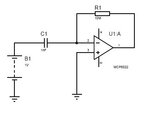uday mehta
Advanced Member level 4
hi,
I am giving ac signal from cro to the device by internal structure of device its capacitance gets change and i want to measure it (which is ultra low i.e. fF range) by measuring current. I am using trans impedance amplifier for measuring. but I am not getting appropriate result.
first of all I want to know that is it possible to measure such a low signal on general purpose pcb with general op amp (means all ordinary components ). I am using mcp6024. is it ok?
if no then is it possible to measurement on two sided pcb with specific components.
if it is possible then what should be the specification of components and which kind of precaution I should make in designing the pcb. I have made ground sealding everywhere on the pcb. is it enough?
and how to reduce coupling which is I am getting from CRO?
I am giving ac signal from cro to the device by internal structure of device its capacitance gets change and i want to measure it (which is ultra low i.e. fF range) by measuring current. I am using trans impedance amplifier for measuring. but I am not getting appropriate result.
first of all I want to know that is it possible to measure such a low signal on general purpose pcb with general op amp (means all ordinary components ). I am using mcp6024. is it ok?
if no then is it possible to measurement on two sided pcb with specific components.
if it is possible then what should be the specification of components and which kind of precaution I should make in designing the pcb. I have made ground sealding everywhere on the pcb. is it enough?
and how to reduce coupling which is I am getting from CRO?

